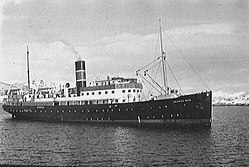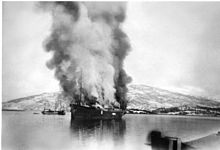Dronning Maud
|
||||||||||||||||||||||
|
||||||||||||||||||||||
|
||||||||||||||||||||||
|
||||||||||||||||||||||
The Dronning Maud was a 1925 commissioned passenger ship of the Norwegian shipping company Det Nordenfjeldske Dampskibsselskab (NFDS), which transported passengers and cargo on the Hurtigruten along the Norwegian coast. On May 1, 1940, Dronning Maud , which had previously been used several times as a troop transport, was bombed, set on fire and sunk at Foldvik by three Heinkel He 111 bombers of Group I of Lehrgeschwader 1 of the German Air Force . 18 people (civilians) were killed and 31 injured. The attack on the unarmed ship that had flown the flag of the Red Cross caused severe criticism of the German warfare.
The ship

The 1,489 GRT steamship Dronning Maud (German "Queen Maud") was built in 1925 at the Fredrikstad Mekaniske Verksted shipyard in Fredrikstad for Det Nordenfjeldske Dampskibsselskab. She was ordered shortly after the loss of the steamer Haakon Jarl , which sank in the Vestfjord on June 17, 1924 after the collision with the Kong Harald . The Dronning Maud was the first new Hurtigruten ship since the Finmarken put into service in 1912 . The construction cost 2.35 million Norwegian kroner based on the monetary value at the time . The ship is named after Maud of Great Britain and Ireland who was Queen of Norway from 1905 until her death in 1938.
The steel Dronning Maud was 71.87 meters long, 11.49 meters wide and had a maximum draft of 4.2 meters. It was powered by triple expansion steam engines, which were also built by Fredrikstad Mekaniske Verksted and made 2,000 PSi. A maximum speed of 16.25 knots was reached during the test drives, with the average cruising speed being 13 knots. The ship was designed to carry 400 travelers. The Dronning Maud was the largest Hurtigruten ship to date and the new flagship on this route. The Prinsesse Ragnhild only took this rank from her in 1931 .
The Dronning Maud was launched on May 8, 1925, completed her test drives in the Oslofjord on June 30, 1925, and was formally handed over to the shipping company on July 3, 1925. Ten days later she left the island of Brattøra on her maiden voyage and has been in regular service from then on. With the Dronning Maud , a new concept for the division of passenger accommodation was presented for the first time. The first class was accommodated in the bow area amidships instead of the previous one and the second class was left out completely to make room for a spacious third class. On March 30, 1926, the Dronning Maud came to the aid of the cargo steamer Pallas , which had run aground near Grønnøy . On January 7, 1927, she helped the British trawler Mac Pemberton , which ran aground in Magerøysund . In October 1929 she was stranded near Florø herself . In 1931, the Dronning Maud was the first Hurtigruten ship to be equipped with a radio station .
In World War II
In the months after the outbreak of the Second World War , the Dronning Maud remained in the usual passenger service. On January 1, 1940, she was involved in a dramatic incident when she assisted with around 100 passengers and 45 crew members on board the German cargo ship Johann Schulte (5,334 t), which was in distress . Johann Schulte , laden with iron ore , had lost her propeller in a storm near the Buholmråsa lighthouse on the coast of Osen . Captain Edward Mill Grundt brought the Dronning Maud close enough to the Johann Schulte to stretch a line between the two ships, with the help of which all 36 German crew members and the two Norwegian pilots could be rescued. Shortly after picking up the castaways , the Johann Schulte hit a reef and sank. The Germans were brought ashore in Rørvik , while the two pilots made the remainder of the northbound voyage. The incident has been described as one of the most notable rescue operations in Norwegian waters and resulted in congratulatory telegrams and gifts for the crew of the Dronning Maud . In the 1960s, Captain Grundt received a gold medal from the German Life Saving Society and a diploma from its Norwegian equivalent, the Redningsselskapet .
When the Wehrmacht occupied Norway on April 9, 1940 , the ship was on a journey from Sandnessjøe to Kirkenes in Finnmark . After her arrival, the Dronning Maud was requested by the Norwegian government as a troop ship. On her first mission, she brought the 1st Battalion of Infantry Regiment 12 (I./IR12) from Sør-Varanger to Tromsø . On April 16, 1940 she ran out of Sjøvegan under the escort of the British heavy cruiser Berwick and the destroyer Inglefield .
On her second mission, she promoted the command staff, an infantry unit as well as radio operators and artillerymen of the Alta Battalion of the Norwegian 6th Division from Alta in Finnmark to Narvik . The rest of the battalion was carried by the ships Kong Harald and Senja . After completing these troop services, it was decided to use the Dronning Maud for the transport of the 6th Landevernssanitetskompani (6th military medical unit ) from Sørreisa to Gratangen . During the preparations for this mission, a three by three meter flag of the Red Cross was stretched across the bridge deck ; Such flags were also hoisted on the two masts . The task of the Dronning Maud was to transport a 119-strong medical staff, eight horses and three trucks.
Sinking
On May 1, 1940 around 11.30 a.m., the Dronning Maud cast off in Sørreisa and arrived three to four hours later in Foldvik on the south bank of the Gratangsfjord . When the ship wanted to dock with the port side on the jetty, it was attacked by three Heinkel He 111 bombers of Group I of Lehrgeschwader 1 of the German Air Force in low flight with bombs and machine guns . Two of the seven bombs dropped were direct hits. The first hit the ship between the bridge and the chimney and exploded in the engine room , blowing the ship's sides away. The second hit just behind the forward hatch and exploded in the hull.
Passengers and crew tried to leave the ship, but only a few lifeboats could be launched because of the fire that broke out. The fire also threatened to spread to the wooden dock. To prevent this, the burning was Dronning Maud pulled away from a fishing boat, a piece of drifted off, then ran aground and sank with heavy list to port . After this attack, the bombers also dropped bombs on the nearby village of Årstein, destroying several buildings and killing two civilians.
Ten passengers and eight crew members of the Dronning Maud , including four women, were killed in the attack. The survivors, some of whom were seriously injured, were initially cared for by the crew of the hospital ship Elieser . The seriously injured were brought to Harstad by the British destroyer Cossack in the evening , while the lightly wounded were transported to Salangsverk by the Elieser . The sinking of the Dronning Maud , an unarmed merchant ship flying the Red Cross flag and with medical personnel on board, caused a lot of anger and criticism against the Germans. From a Norwegian perspective, the Dronning Maud was a hospital ship and was protected by the Geneva Conventions . The Germans countered that the ship could not be fully recognized as a hospital ship, as the hull was still black and not painted white with a green stripe, as is usual for a hospital ship.
The wreck
The wreck of the Dronning Maud was never lifted and lies upright on the keel near Foldvik ( 68 ° 41 ′ 55 ″ N , 17 ° 26 ′ 22 ″ E ) in water 26 to 35 meters deep. It's easy to dive and you can easily get around it with one dive . The upper edge of the stern is at 32 m water depth, the bow at 25 m. Because of this depth, a decompression stop is inevitable. A boat is required to get to the wreck site.

